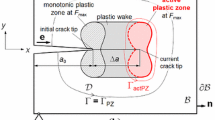Abstract
To quantify the growth behaviour of fatigue cracks growing towards microstructural barriers or elastic obstacles, parametric solutions are obtained for crack-tip opening displacement and plasticity-induced crack closure of a mode I fatigue crack growing towards elastic obstacles. Three common bi-material systems are analysed using the finite element method, in which both constituent materials have identical elastic properties but only the phase that contains the crack can deform plastically. It has been found that under monotonic loading the crack-tip opening displacement decreases as the crack-tip approaches the interface boundary, but reaching a non-zero value when the crack-tip terminates at the boundary. For a fatigue crack growing under constant amplitude loading, the crack-closure stress has been found to increase as the crack grows towards the barrier. Based on these results a mechanistic model is proposed to quantify the influence of stress level on the fatigue threshold of microstructurally small fatigue cracks, with predictions being in close agreement with experimental data.
Similar content being viewed by others
References
Budiansky, B. and Hutchinson, J.W. (1978). Analysis of closure in fatigue crack growth. Journal of Applied Mechanics 45, 267–275.
Elber, W. (1970). Fatigue crack closure under cyclic tension. Engineering Fracture Mechanics 2, 37–45.
Haddad, M.H. El, Smith, K.N.and Topper, T.H. (1979). Fatigue crack propagation of short cracks. Journal of Engineering Materials and Technology 101, 42–46.
Hutchinson, J.W. and Tvergaard, V. (1999). Edge-cracks in single crystals under monotonic and cyclic loads. International Journal of Fracture 99, 81–95.
Kim, A.S., Suresh, S. and Shih, C.F. (1997). Plasticity effects on fracture normal to the interfaces with homogeneous and graded compositions. International Journal of Solids and Structures 34, 3415–3432.
Leevers, P.S. and Radon, J.C. (1982). Inherent stress biaxiality in various fracture specimen geometries. International Journal of Fracture 19, 311–325.
Liu, H.W. (1998). A dislocation barrier model for fatigue crack growth threshold. International Journal of Fracture 93, 261–280.
McDowell, D.L. (1996). Basic issues in the mechanics of high cycle metal fatigue. International Journal of Fracture 80, 103–145.
Miller, K.J. (1991). Metal fatigue – past, current and future. Proceedings Institution of Mechanical Engineers 205, 1–14.
Miller, K.J. (1993a). The two thresholds of fatigue behaviour. Fatigue and Fracture of Engineering Materials and Structures 16, 931–999.
Miller, K.J. (1993b). Materials science perspective of metal fatigue resistance. Materials Science and Technology 9, 453–462.
Navarro, A. and de los Rios, E.R. (1987). A model for short fatigue crack propagation with an interpretation of the short-long crack transition. Fatigue and Fracture of Engineering Materials and Structures 10, 169–186.
Navarro, A. and de los Rios, E.R. (1988). An alternative model of the blocking of dislocations at grain boundaries. Philosophical Magazine A57, 37–42.
Newman, J.C. (1998). The merging of fatigue and fracture mechanics concepts: a historical perspective. Progress in Aerospace Sciences 34, 347–390.
Rice, J.R. (1974). Limitations to the small scale yielding approximation for crack tip plasticity. The Journal of Mechanics and Physics of Solids 22, 17–26.
Rose, L.R.F. and Wang, C.H. (2001). Self-similar analysis of plasticity-induced closure of small fatigue cracks. The Journal of Mechanics and Physics of Solids 49, 401–429.
Saeedvafa, M. and Rice, J.R. (1992). Crack tip fields in a material with three independent slip systems: NiAl single crystal. Modelling and Simulation in Material Science and Engineering 1, 53–71.
Sugimura, Y., Lim, P.G., Shih, C.F. and Suresh, S. (1995). Fracture normal to a bimaterial interface: effects of plasticity on crack-tip shielding and amplification. Acta Metallurgica Materials 43, 1157–1169.
Tanaka, K. (1987). Mechanisms and mechanics of short fatigue crack propagation. JSME International Journal 30, 1–13.
Tanaka, K., Akiniwa, Y., Nakai, Y. and Wei, R.P. (1986). Modelling of small fatigue crack growth interacting with grain boundary. Engineering Fatugue Mechanics 24, 803–819.
Tracey, D.M. (1976). Finite element solutions for crack-tip behaviour in small-scale yielding. Journal of Engineering Materials and Technology 98, 146–151.
Wang, C.H and Miller, K.J. (1992). The effects of mean shear stress on short fatigue crack growth. Fatigue and Fracture Engineering Materials and Structures 15, 1223–1236.
Wang, C.H. (1996). Short fatigue crack growth under asymmetrical loading. Journal of Engineering Materials and Technology 118, 362–366.
Wang, C.H. and Rose, L.R.F. (1999a). Crack-tip plastic blunting under gross-section yielding and implications for short crack growth. Fatigue and Fracture of Engineering Materials and Structures 22, 761–773.
Wang, C.H. and Rose, L.R.F. (1999b). Self-similarity of the plastic wake of short fatigue cracks. Proceedings of International Workshop on Fracture Mechanics and Advanced Engineering Materials. University of Sydney, Australia, 20–27.
Williams, M.L. (1957). On the stress distribution at the base of a stationary crack. Journal of Applied Mechanics, 24, 111–114.
Author information
Authors and Affiliations
Rights and permissions
About this article
Cite this article
Wang, C., Hutchinson, J. Interactions of fatigue cracks with elastic obstacles. International Journal of Fracture 109, 263–283 (2001). https://doi.org/10.1023/A:1011041612941
Issue Date:
DOI: https://doi.org/10.1023/A:1011041612941




